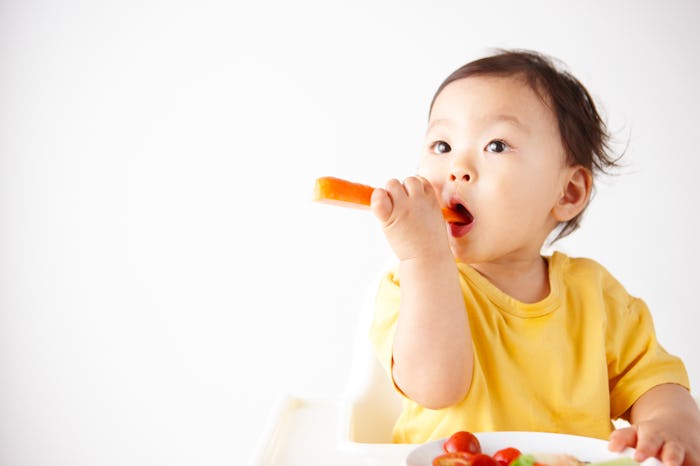Life

So It Turns Out Toddlers Can Get Jaundice, Too, But Wait'll You Hear Why
It’s not uncommon for newborns to be born with a slight yellowing of the skin and eyes, known as jaundice. While this usually clears on its own a few weeks after birth, if you notice your older kiddo is looking a bit yellow, you may be wondering: Can toddlers get jaundice? The short answer is yes, but it’s rare.
Jaundice is caused by a buildup of bilirubin, “a chemical that forms when red blood cells are broken down,” Dr. David Hill, pediatrician and author, tells Romper. The reason it’s more common in newborns is because infants have high concentrations of red blood cells, Hill says, “and their cells are less stable, so they break down faster. Sometimes the body’s clearance system in the liver and the colon can’t keep up.” Bilirubin is actually yellow in color, and when it's not processed fast enough through the liver, the excess is, “deposited in the skin, muscles, and mucous membranes of the body,” per La Leche. That can cause the skin to take on a yellowish or golden color. “Anything that increases the breakdown of blood cells [in newborns], like antibodies from mom’s blood, or decreases the production of poop, like poor feeding, can make [jaundice] worse,” Hill tells Romper.
Rest assured that while jaundice may look alarming in newborns, it’s usually not a huge concern. A 2007 study in the Paediatrics & Child Health Journal found that “most jaundice is not harmful to your baby.” Sometimes it will clear on its own within a few weeks, though to speed the process, many infants undergo phototherapy, which means they're placed under a blue-light lamp.
In toddlers, however, signs of jaundice can indicate that something more severe is going on. Causes of this condition in toddlers can include, “hepatitis, some blood disorders, [and] cancer,” Hill tells Romper. Other reasons for jaundice in children may include gallstones, Epstein Barr Virus, or Hemolytic anemia, per Healthline.
This all sounds pretty severe and scary, but if you notice your child is looking a little more yellow than usual, don’t immediately panic. Toddlers will sometimes have an “orange coloring to the palms and the tip of the nose from eating lots of orange vegetables like carrots and squash. The difference is that in jaundice, the whites of the eyes look yellow. With beta carotene from vegetables, they stay white.” So if you’re really concerned, look at your child’s eyes (and mentally calculate how many baby carrots they’ve been snacking on).
If you are still concerned, Hill says to call your pediatrician immediately. Doctors will typically be able diagnose jaundice just by looking at a child, but the underlying cause may initially be harder to find. Typically they will do a blood test and a urinalysis (per Healthline) to check for levels of bilirubin in the body and any abnormalities in the liver. And while it's always worth getting checked, especially if you notice yellow eyes, jaundice is toddlers is rare, and if your child is looking a little bit yellow or orange, the more common cause is beta-carotene from foods like yellow peppers, squash, carrots, sweet potatoes, cantaloupe, and even dark leafy vegetables. Hill says there are no reported toxic effects of beta carotene, and going big on the orange foods just means your kiddo may look temporarily like a cute little oompa loompa (which seems like a fair trade off if they're eating tons of vegetables).
Studies referenced:
Canadian Paediatric Society. (2007). Jaundice in newborns. Paediatrics & Child Health Journal. doi: 10.1093/pch/12.5.409
Experts: Dr. David Hill, pediatrician and author of Co-parenting Through Separation and Divorce: Putting Your Children First
This article was originally published on